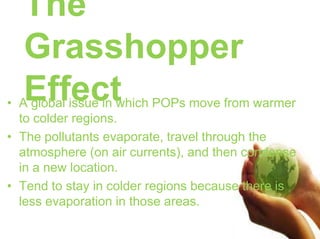
Air and energy issues student version
- 1. The Grasshopper Effect A global issue in which POPs move from warmer to colder regions. The pollutants evaporate, travel through the atmosphere (on air currents), and then condense in a new location. Tend to stay in colder regions because there is less evaporation in those areas.
- 2. The Grasshopper Effect Less Evaporation Colder Polar Regions Temperate Regions More Evaporation Hotter Equatorial Regions
- 3. The Ozone Layer Forms the stratosphere and protects us from the suns UV Radiation Human activities are upsetting the balance of this gas In 1983 it was confirmed that there was a whole in ozone (over Antarctica) In 1998 the hole measured 26 million Km’s (roughly the size of Australia) How is it being destroyed? Chloroflouorocarbons (CFCs)- once they rise into the stratosphere, they become exposed to UV radiation and release chlorine atoms A single chlorine atom can destroy thousands of molecules of ozone
- 4. The Ozone Layer How is it being destroyed? Chloroflouorocarbons (CFCs)- once they rise into the stratosphere, they become exposed to UV radiation and release chlorine atoms A single chlorine atom can destroy thousands of molecules of ozone
- 5. Copy to your notes: Acidic Deposition Diagram pg 288 Effects of Acidic Deposition Chart pg 290 Effects of UV Radiation pg 294 What is the Montreal Protocol?
- 6. Energy Issues: Energy Use Worldwide: Industrialized Countries Non renewable- Oil- Coal- Natural Gas- Nuclear Power- Renewable- Hydroelectric, solar and geothermal- Biomass-
- 7. Energy Issues: Developing Countries Non renewable- Oil - Coal- Natural Gas- Nuclear- Renewable- Hydroelectric, solar and geothermal- Biomass-
- 8. Energy Issues: Conventional Energy Uses Fuels- materials that are burned to produce heat or power Traditional: Wood Field crops Fecal material Peat (decaying plant matter found in bogs)
- 9. Energy Issues: Conventional Energy Uses Continued Fossil Fuels: Coal Petroleum and Natural Gas Migration (crude oil and natural gas migrated sideways and upward from the place of their formation, permeate into sedentary rocks
- 10. Energy Issues: Alternative Energy Uses: Solar Energy Passive solar energy Active solar energy Solar cookers Photovoltaic cells Advantages and Disadvantages Hydroelectric Power (water) Energy from Oceans Advantages and Disadvantages
- 11. Energy Issues: Alternative Energy Uses Continued Geothermal Energy Advantages and Disadvantages Wind Energy Advantages and Disadvantages Nuclear Energy Advantages and Disadvantages Biomass Biogas Ethanol and Methanol Advantages and Disadvantages
- 12. Energy Issues: Alternative Energy Uses Continued Hydricity (hydrogen) Means of storing electricity for future use Hydrogen can be stored and liquefied Helps for us to reduce our dependence on fossil fuels and more like western Europe/ Japan Advantages Flexibility Reduce oil dependency Reduction of environmental damage = water Disadvantages Replacing current energy infrastructure Will take evolutionary change Cornucopian view for a sustainable future